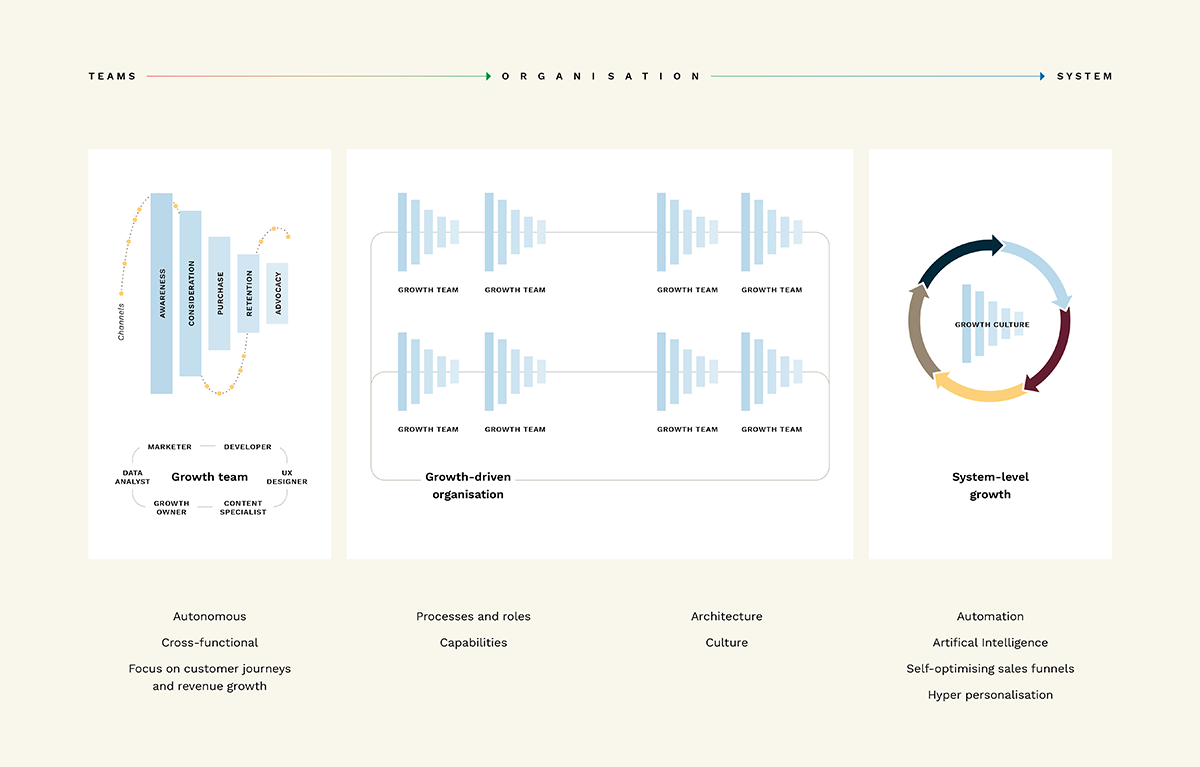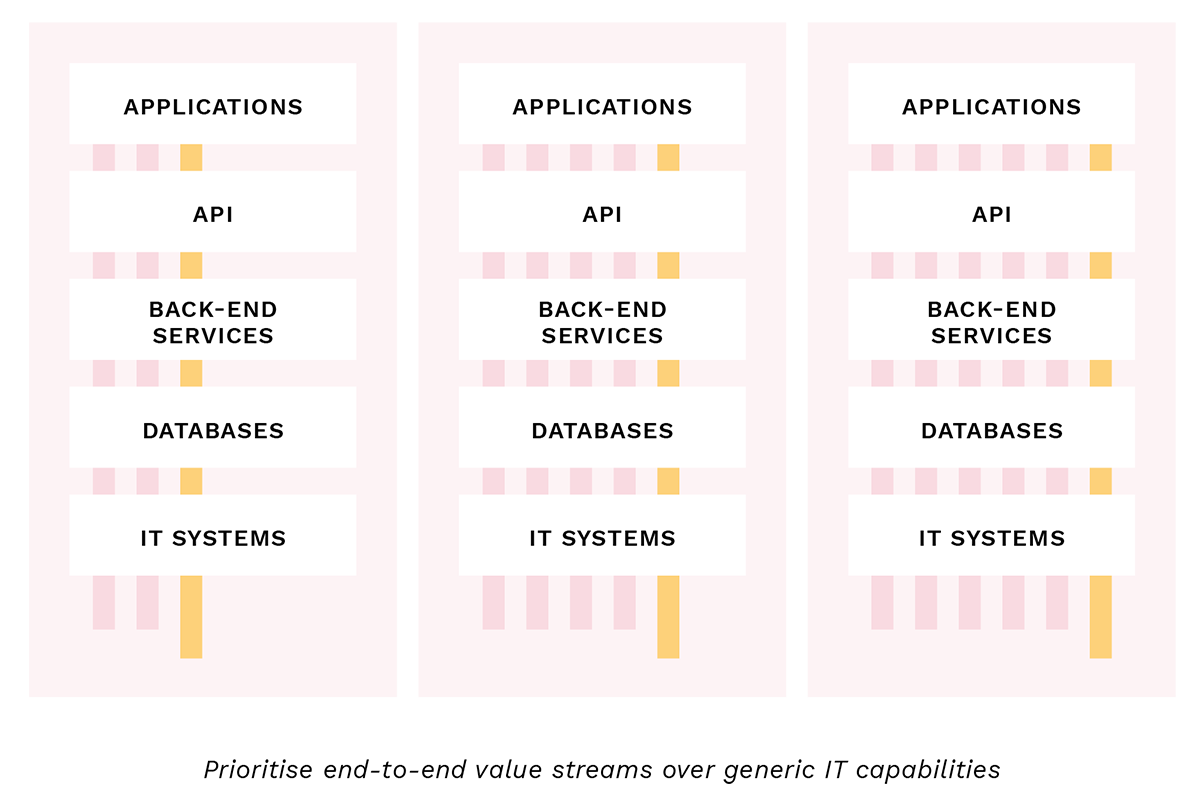The Data Handbook
How to use data to improve your customer journey and get better business outcomes in digital sales. Interviews, use cases, and deep-dives.
Get the book
Transforming sales is not just about introducing new technology – it’s about changing processes too. This means building cross-functional growth teams and an organisational model that supports them.

Companies are traditionally organised by function, with each having its own goals. Marketing, for example, is measured by the number of leads handed over to the sales department. Sales may be measured by the number of opportunities generated and deals closed. And IT is responsible for and measured on its development of technology that should help multiple functions.
This functional split means that the customer journey and digital revenue optimisation often take a back seat, or happen in their own silos. Hence, an increasing number of growth companies are now organising by customer journey or sales funnel instead. They’re leaving functional goals and siloed thinking behind for a new world of self-optimising and hyper-personalised sales funnels with the capacity to predict and meet customer needs.
With this shift from a function-led to a customer-journey led model, we may see a change in the roles of the ecommerce manager or sales manager as we know them today. In fact, these roles may cease to exist in the near future. Consumer sales or B2B long-tail sales processes – such as pricing, advertising, conversion optimisation, inventory and logistics optimisation – are all being automated. This frees people to focus on strategic decision-making and key account relationships instead.
To address these rapid technological changes, many corporations have initiated digital transformation programs. But these programs often lack concrete business goals.
The question is: what should be digitised, and why?
The answer is not to talk about tech-driven transformation, but rather about process digitisation. It's the sales process that is transforming in both its analogue and digital dimensions. And this transformation is driven by technology development, customer expectations and globalisation. So in order to compete in future revenue streams, a company needs to have a digital sales strategy.
This article presents a three-level framework to address digital sales transformation in corporations.

Level one: building growth teams
The very first step in transforming sales is to break the functional silos along the sales funnel. When customer acquisition (digital marketing), sales-channel development (IT) and nurturing (customer development) work in separate silos with different KPIs, you lose money, sacrifice efficiency, and lack a holistic understanding of your sales funnel.
What you need is a growth team: a modern take on a sales team that optimises the entire sales funnel. A growth team may comprise digital marketers, developers, analysts, copywriters, designers and a growth owner who prioritises tasks or experiments. Every growth team member focuses on revenue growth – not features.
We recommend starting with a small growth team and then scaling up after getting some concrete early results to share with the rest of the organisation. Aside from revenue growth, the key outcomes of this phase are increased motivation among employees (as they see the results of their work every day) and significant improvements in efficiency.
A cross-functional growth team can also prioritise experiments based on their business potential. As Lauri Eurén writes in his blog on customer centricity, marketing departments should not be blindly minimising cost per every customer acquisition (CPA). They should instead focus on converting the leads with the most potential into customers, and then growing the life-time value of these customers.
To read more about setting up growth teams, read Columbia Road’s "The Growth Hacker's Handbook".
Level two: growth-driven organisations
An organisation that is structured to be growth-driven has an operational model and processes that support the optimal scaling of multiple growth teams. It’s the organisation’s responsibility to make sure it has removed all possible roadblocks to creating an environment where growth teams can work fast, autonomously and with a strong mandate to own the entire sales process.
Driving an agile, growth-driven organisational mindset requires transparency, trust and patience. It’s key that growth teams feel the confidence to be able to communicate to the rest of the organisation about the needs and pain points that prevent them from unlocking sales opportunities.
The organisation needs to be responsive to the growth teams’ needs and give them access to information from across the organisation. Growth teams might want to get help from the rest of the organisation for questions like:
● How can we reach the most potential cross-shoppers this week?
● Can we automate an aggressive win-back campaign for the most valuable clients who are most likely to churn?
● Can we personalise the digital sales channel experience based on visitors’ online behaviour?
The task of building digital-sales capabilities of this kind should not be on the growth teams themselves (their focus should be on daily revenue creation). The responsibility should lie with digital-sales capability teams or business IT teams that work closely with the growth teams.
Instead of thinking in terms of technology or systems, we need to think about how we can create customer value every day that will convert into sales revenue. For example, a data-warehouse program should prioritise solving specific business problems as quickly as possible. A project of this kind has zero business value until it goes live.
Build one vertical stream at a time
When developing growth-driven downstream processes and related capabilities, it is important to proceed one vertical capability at a time – not to try building horizontal generic capabilities for every possible use case.
For example, you may have identified that a B2B salesperson could grow sales revenue with a tool that predicts customers’ cross-category needs and helps the salesperson to build a quote in less than a minute. If something like this is at the top of your priority list, you should split the problem into smaller parts and try to validate your hypotheses as quickly and cheaply as possible.
Instead of immediately building a sales configuration application with CRM integration – and deploying a full data warehouse platform to support prediction – you should rather first validate the business value with a landing page and a mock-up database. Only after getting positive results should you invest in scaling horizontally.

Transformation happens ‘slice by slice’ when organisations focus on rapid value creation rather than horizontal generic IT capabilities. While this means growth teams may see improvements in their sales capabilities happening only in increments, it makes them much faster at identifying and solving problems.
Level 3: system-level sales
Modern startups often focus on their sales system first, and only build their organisational capabilities later. The reason this is important for established companies to understand is because your future revenue streams may be affected by new market entrants who approach sales from a completely different perspective.
When you apply system-level thinking to sales – as startups often do – then you naturally focus on your entire value network.
The most known examples of this are the multi-sided platforms where one side aims for large volumes while the other side does the monetisation. The best-known examples include giants like Facebook, Uber and AirBnB.
However, system level change can also be driven in more traditional environments. N26, Revolut or Transferwise are good examples of completely new players in the financial-services industry, running highly-optimised and automated digital sales processes. They do not try to offer all the same services as traditional banks, but instead focus on creating more value within a smaller area than traditional banks can do.
Having a narrower focus enables these companies to manage the entire value network. Their onboarding processes utilise AI for real-time customer profiling (e.g. credit ratings or hyper-personalised offerings) and their API-strategy connects the service with other value streams.
Similarly, retailers can provide demand prediction for their key suppliers and service providers in order to minimise inventory and delivery time. Energy companies balance between demand peaks caused by consumers and industry, weather events, fluctuating fuel prices, inventory costs and many other factors that influence the energy market.
Sales, when looked at from the entire value network perspective, has so many dimensions – all of which affect each other – that it is impossible for humans to get it perfectly right. This is where new AI technologies and automation come into the picture.
By automating all of their sales, marketing and customer-service processes to gradually replace growth teams, Level 3 companies create their competitive advantage through both process efficiency and revenue optimisation. And by offering hyper-personalised customer journeys.
If you still optimise supply and demand only, then you need to move quicker. Start your first AI or automation experiments today, and think about the entire value network of your company when reengineering your sales.
Learn how to thrive at the turning point of digital sales by reading The Digital Sales Transformation Handbook. Discover how digital sales transformation is changing companies, and how your business can leverage this change through organisational development, customer experience, ways-of-working and technology. Featuring interviews with industry experts, such as Marta Dalton (eCommerce Director for Unilever and Coca-Cola previously), Risto Siilasmaa (Founder of F-Secure) and Antti Kleemola (CDO of VR, Finnish Railways).
The Data Handbook
How to use data to improve your customer journey and get better business outcomes in digital sales. Interviews, use cases, and deep-dives.
Get the book





